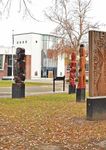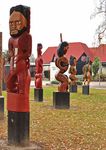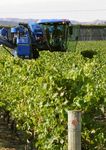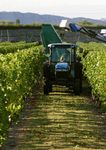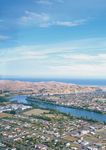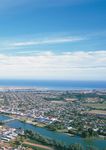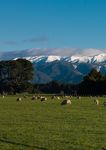MATARIKI Hawke's Bay Regional Economic Development Strategy and Action Plan 2016 - 'Every household and every whānau is actively engaged in ...
←
→
Page content transcription
If your browser does not render page correctly, please read the page content below
MATARIKI Hawke’s Bay Regional Economic Development Strategy and Action Plan 2016 ‘Every household and every whānau is actively engaged in, contributing to and benefiting from, a thriving Hawke’s Bay economy.'
KO TE KAINGA, KO TE
WHĀNAU TE PŪTAKE; HE
TAU-UTUUTU TE HONONGA
KO TE ŌHANGA O TE MATAU
A MĀUI E PAKARI NEI.
M ATA R I K I – H AW K E ’ S B AY R E G I O N A L E C O N O M I C D E V E L O P M E N T S T R AT E G Y A N D AC T I O N P L A N 2 0 1 6MATARIKI – TE WHETU HERI KAI
The appearance of Matariki is the sign for future prosperity
The rise of Matariki in mid-June marks the Māori new year: a time for celebration,
reflection and planning. If it rises clear and bold, then ‘He kaihaukai te tau’ we expect
prosperity in that upcoming year. If it is dim and forgettable, ‘He tau nihoroa’, a
lacklustre year with difficult conditions is in store.
Matariki means three things to this regional economic development strategy. It is its
name, its conceptual framework, and the commitment by all partners for robust annual
review and refinement. As Matariki has seven stars, the Matariki framework has seven
points, each pivotal to maintaining the direction and integrity of the strategy for all the
partners and stakeholders. Matariki is also key to ensuring that as a region we orientate
ourselves towards the vision: ‘Every household and every whānau is actively engaged
in, contributing to and benefiting from, a thriving Hawke’s Bay economy.’
Matariki Framework for Hawke's Bay Regional Economic Development
Partnership by Values and worldview underpinning the strategy
co-design and its actions are an expression of co-design, and
the implementation and monitoring are an inclusive
collaboration. A treaty principle.
Outcomes for every All actions, initiatives and projects in the Action Plan
household and every must provide outcomes in line with the vision.
whānau
Build our people’s There must be an emphasis on developing our
capability people alongside infrastructure, assets and
businesses.
Equality A treaty principle, this requires reflection on who
the intended audience and beneficiaries are, and a
commitment to that being inclusive and equitable.
Business Growth Our regional actions are designed to be as
Agenda 2015 consistent as possible with both national economic
strategies.
He kai kei aku ringa
Whai rawa Optimising assets in a full, holistic and sustainable
way.
Pōtikitanga Developing an enterprise mindset. Driving the
thinking that goes behind business growth.
4Ā-ROHE, Ā-KĀNOHI
A regional strategy making the most of Hawke’s Bay
and its people
This document sets out the Matariki – Hawke’s Bay Regional Economic Development
Strategy and Action Plan 2016 (REDS). We want this strategy to play a real part in economic
growth in our region by offering practical guidance to councils, businesses,
iwi, hapū, and other organisations and agencies.
Some of the strategy is about practical things that we can – or must – do to help growth.
We have a lot of things going for us, and we have to make the most of them. Other parts
of it are about the things we have to stop doing, whether it’s conflicting interpretation of
regulations or needless negativity, because they are getting in the way of growth. We have
to be honest about the areas where we’re holding people back, and deal to them. Both bits
are important.
He toa takitini – A strategy developed in partnership
We’re very proud that this strategy is, for the first time, a truly regional strategy, and that it
has been designed in partnership, as aspired for in the principles of Te Tiriti o Waitangi. The
strategy recognises the overarching frameworks of the Business Growth Agenda (2015) and
its six growth areas and the Māori Economic Development Advisory Board’s He Kai Kei Aku
Ringa (2012) with its six goals.
This strategy involves the public sector at all levels and the private sector of all sizes. Māori
partners were represented by Te Kāhui Ōhanga o Takitimu - a collective of Ngāti Kahungunu
Iwi and Hapū post treaty settlement groups committed to driving economic development
in Hawke's Bay. The strategy is focused on building from the whānau level to generate a
healthier, wealthier, more inclusive and fulfilled population. It will only work if we all commit
to supporting it and holding accountable the people who agree to deliver their parts of the
process.
We need to acknowledge that numerous private, non-governmental and public
organisations are already involved with economic development delivery in Hawke’s Bay.
If we are to achieve higher levels of economic performance and whānau success, their
continued involvement in a way that recognises the role of each contributor is vital. So
progressive networking between the different contributing organisations will be crucial.
He aronga whānui: he whakamana i te tangata – A strategy that diversifies
and empowers
With this strategy, we want to make the most of Hawke’s Bay’s competitive advantages.
We’re looking to diversify the economic base of the region. We want to create lasting jobs
for our people and to use our resources in a sustainable way.
To do these things, the strategy needs to be clear and succinct, and describe an approach
that is workable and collaborative. That way we hope it will encourage buy-in from
stakeholders and be something that our region’s councils, businesses, iwi, hapū, and other
organisations and agencies will use and embrace.
Nā wai, mā wai? – Who worked on the strategy?
A project management team worked on the strategy. They were guided by a governance
group that included the Chief Executives of the local and regional councils and
representatives from leading private sector, iwi, hapū, educational and health organisations
in the region.
M ATA R I K I – H AW K E ’ S B AY R E G I O N A L E C O N O M I C D E V E L O P M E N T S T R AT E G Y A N D AC T I O N P L A N 2 0 1 6Figure 1: Hawke’s Bay Economic Development Framework
MATARIKI – HAWKE’S BAY REGIONAL
ECONOMIC DEVELOPMENT STRATEGY 2016
Every Household and Every Whānau is Actively
Engaged in, Contributing to and Benefiting from,
a Thriving Hawke’s Bay Economy.
Hawke’s Bay will be NZ’s most innovative
region, the leading exporter of premium primary
produce, and a hub for business growth.
Become a beacon
for investment, new Improve pathways
business, and skilled to and through
migrants. employment.
Promote greater
Lead in the provision
innovation,
of resilient physical,
productivity
community and
and agility.
business infrastructure.
Identify Enhance visitor
and support satisfaction and
existing businesses increase spend.
wanting to grow.
Champion sustainability:
Celebrate world class lifestyle social, economic and
and environment. environmental.
6OUR VISION:
Every household and every whānau is actively engaged in, contributing to and benefiting
from, a thriving Hawke’s Bay economy.
We will do this by making Hawke’s Bay NZ’s most innovative region, the leading exporter
of premium primary produce, and a hub for business growth.
Strategic directions
• Improve pathways to and through employment
• Identify and support existing businesses wanting to grow
• Promote greater innovation, productivity and agility
• Become a beacon for investment, new business, and skilled migrants
• Lead in the provision of resilient physical, community, and business infrastructure
• Enhance visitor satisfaction and increase spend
The above strategic directions will be viewed through the lens of ‘enabling whānau
success’ and will collectively require coordinated execution at a regional level.
Goals
• To increase the median household income above the national median, for
equitable growth
• To accelerate job growth, in particular to create 5000 net jobs in five years
• To raise to the top quartile of New Zealand regions in regional economic growth
and sustain that position long-term
Objectives
• To have a Hawke’s Bay-led, government-supported, investment in infrastructure
• To deliver consistent interpretation and communication of rules and regulations to
improve the efficiency of regulatory processes across local government within
the region
• To establish an enduring private/public economic development delivery model
• To leverage the region’s natural advantages to optimise the export value of
agribusiness and food and beverage manufacturing, further enhancing the
premium positioning and value-add of Hawke’s Bay produce
• To build upon and sustainably manage visitor growth
• To foster and support entrepreneurship
• To grow Māori participation in, and benefit from, economic development
M ATA R I K I – H AW K E ’ S B AY R E G I O N A L E C O N O M I C D E V E L O P M E N T S T R AT E G Y A N D AC T I O N P L A N 2 0 1 6THE CONTEXT: THE HAWKE’S BAY
ECONOMIC DEVELOPMENT FRAMEWORK
Figure 1 (page 6) shows the strategic economic development framework. The goal of
building a more valuable and sustainable export-led economy through diversification is
underpinned by six cross-cutting themes that are designed to enhance the economic
prosperity of the region. The framework also recognises the region’s world-class
lifestyle, its environment and the importance of sustainability.
THE CONTEXT: OVERVIEW OF OUR REGION
Hawke’s Bay is a relatively specialised regional economy with a small, but stable,
population. Economic growth is gathering pace – we have a lot of things happening.
We still have much to do particularly for our high-needs communities and our children:
a third of our children are growing up in poverty and nearly half of Māori under five are
living in households that depend on benefits. It is critical that opportunities and benefits
of a thriving Hawke’s Bay economy be accessed equitably.
Our consultation process for preparing this strategy revealed a regional economy that
is expanding and poised to expand further. But we also observed growing constraints
and pressures that need urgent attention. The region has a good foundation. As well,
potential developments are on the way that, if carried out, are likely to lead to major
new opportunities. We also found evidence of rapidly emerging new business activity
in a range of service sectors.
The Matariki – Hawke’s Bay Regional Economic Development Strategy and Action
Plan 2016 applies to the geographical areas of Central Hawke’s Bay District, Hastings
District, Napier City, Wairoa District and small parts of Rangitikei District and Taupō
District. The boundary coincides with the Hawke’s Bay Regional Council (see Figure
2A). The area of focus for Te Kāhui Ōhanga o Takitimu includes Hawke's Bay, but goes
beyond its boundaries, spanning the full length of the Ngāti Kahungunu rohe Mai Paritū
ki Turakirae, from North of Te Mahia to Southern Wairarapa and linking to other Takitimu
waka iwi and into the Pacific. The map provides locations of the different Kahungunu
entities, including post treaty settlement groups and taiwhenua (Figure 2).
8Figure 2 Geographical Context for the
Matariki – Hawke’s Bay Regional Economic
Te Tira Whakaemi o Te Wairoa
N
Development Strategy and Action Plan 2016
Figure 2A Ngai Tuhoe
Hawke's Bay
Ruapani ki Waikaremoana
Wairoa Taiwhenua
!
Ngati Hineuru
Wairoa District
Te Taiwhenua O Te Whanganui-a-Orotū
Hastings District
Te Taiwhenua O Heretaunga
Napier City
Ngati Pahauwera
Maungaharuru-Tangitū Trust
Te Taiwhenua O Tamatea
Mana Ahuriri
Central Hawke's Bay District Heretaunga Tamatea
Tāmaki-nui-a-Rua Taiwhenua
Kahungunu ki Wairarapa
Taiwhenua
Ngati Kahungunu ki Wairarapa - Tamaki Nui a Rua
DATA FROM: Information obtained from the Hawke's Bay Regional Council's Geographic Legend
Information Systems Database.
HB Regional Council Boundary
LIMITATIONS AND COPYRIGHT: This map may not be reproduced or transmitted to any other
party, in any form or by any means, electronic, mechanical, photocopying, recording or otherwise, Ngai Tuhoe
without the written permission of the copyright holder. Ngati Hineuru
DISCLAIMER: The Hawke's Bay Regional Council cannot guarantee that the data shown on this Ruapani ki Waikaremoana
map is 100% accurate.
Ngati Kahungunu Iwi Boundary
M ATA R I K I – H AW K E ’ S B AY R E G I O N A L E C O N O M I C D E V E L O P M E N T S T R AT E G Y A N D AC T I O N P L A N 2 0 1 6OUR STRATEGIC DIRECTIONS
In the rest of this document we enlarge on each of the strategic directions for the Matariki
– Hawke’s Bay Regional Economic Development Strategy and Action Plan 2016:
• Improve pathways to and through employment
• Identify and support existing businesses wanting to grow
• Promote greater innovation, productivity and agility
• Become a beacon for investment, new business, and skilled migrants
• Lead in the provision of resilient physical, community, and business infrastructure
• Enhance visitor satisfaction and increase spend
ACTION PLAN DEFINITIONS:
‘Lead’ The agency held accountable for, and the delivery of, the action.
‘Partner’ Enabler through co-design, participation in, and support of, the implementation
of the action.
Abreviation Full Title
BHB Business Hawke's Bay
Callaghan Callaghan Innovation
CHBDC Central Hawkes Bay District Council
Councils Local Territorial Authorities for Central Hawke's Bay, Hastings,
Napier and Wairoa together with Hawke's Bay Regional Council
EIT Eastern Institute of Technology
HBDHB Hawke's Bay District Health Board
HBRC Hawke's Bay Regional Council
HBT Hawke's Bay Tourism
HDC Hastings District Council
MBIE Ministry of Business, Innovation and Employment
MPI Ministry for Primary Industries
MSD Ministry of Social Development
NCC Napier City Council
NGO Non-governmental organisation
NZTA New Zealand Transport Agency
10NZTE New Zealand Trade and Enterprise
TEOs Tertiary Education Organisations
TKO Te Kāhui Ōhanga
TPK Te Puni Kōkiri
WDC Wairoa District Council
1. Strategic Framework
Work Area Actions Lead Agency Key Partners
1. Areas of 1.1 Undertake a stocktake of REDS Councils, HBT,
Strategic Focus the organisations involved Governance BHB, Iwi, Hapū,
in economic development in Group Government
the region and recommend Agencies
the regional economic
development delivery model
to give effect to this strategy.
1.2 Investigate a business HDC Councils,
case to Government for BHB, Iwi,
Hawke's Bay to leverage Hapū,
a sustainable competitive Government
differentiation for long-term Agencies,
advantage Private
sector
1.3 Develop research NCC Councils,
capability to support the Waikato
work and provide the University
evidence base for REDS
implementation
1.4 Develop measures for REDS Project Councils, BHB,
monitoring the potential Team Iwi, Hapū,
impact and ultimate success Government
of the strategy against the Agencies,
vision, and the principles of Private sector
the Treaty of Waitangi
M ATA R I K I – H AW K E ’ S B AY R E G I O N A L E C O N O M I C D E V E L O P M E N T S T R AT E G Y A N D AC T I O N P L A N 2 0 1 6WE WILL ACHIEVE OUR VISION BY MAKING
HAWKE’S BAY THE MOST INNOVATIVE REGION
IN NEW ZEALAND, THE LEADING EXPORTER
OF PREMIUM PRIMARY PRODUCE, AND A HUB
FOR BUSINESS GROWTH.
12M ATA R I K I – H AW K E ’ S B AY R E G I O N A L E C O N O M I C D E V E L O P M E N T S T R AT E G Y A N D AC T I O N P L A N 2 0 1 6
ARA-RAU, HAUKŪ-NUI, HĀRO-O-TE-KĀHU
Improve pathways to and through employment
We know that access to ongoing, regular paid employment is a significant driver of
improved health and wellbeing for households and whānau, and that it reduces crime
and violence. Creating and enhancing pathways into employment is not a ‘nice to have’
for Hawke’s Bay – it’s a ‘must have’. Regionally we must take action to minimise any
potentially negative effects of external economic changes.
‘Pathways to and through employment’ is a strategy that can contribute to developing
local resilience. By creating an empowered, more highly skilled and option-rich Hawke’s
Bay population, we will be better equipped to deal with both future employment needs
and changing market dynamics. To do this, we need to build clear pathways into, and
subsequently through, employment.
We know that employment opportunities exist across all sectors currently and we need to
be more creative to ensure that they are captured by local people. Globally and nationally
we’ve had a history of shifting markets and changing economic policies that are outside
our direct control but have had a significant impact on households and on whānau.
Forestry, freezing works, and farming in particular have gone through fluctuations that
have affected local people’s ability to be self-determining and financially stable.
The lower-skilled and unskilled workers are the most vulnerable through such market
upheavals, which emphasises the importance of education and training as a critical
part of the pathway to sustainable employment. We also have a local dependency on
seasonal labour – 30% of which is currently filled by imported labour – because we
struggle to match available labour supply with work opportunities.
On top of this, the world is continuing to change at an increasing pace, driven by
advances in technology and global connectedness, and we need to give our people the
skills and knowledge to help them navigate this uncertainty.
NGĀ HUARAHI WHAI RAWA – PATHWAYS TO EMPLOYMENT
When we refer to ‘pathways to employment’, we mean the need to train people to be
work-ready, who can then be matched with ‘employee-ready employers’. We’re also
talking about creating a skilled and resilient population that is equipped to thrive in an
uncertain future.
Training, the first of these pathways, will require industry to lead and government
agencies, schools, Eastern Institute of Technology (EIT) and other tertiary providers to
respond in a coordinated way. A coordinated response to training will lead to an effective
‘supply chain’ that has benefits for all involved – but most importantly, for the person
seeking employment.
How we incentivise and appropriately align these pathways will require changes in
practice and government policy. We need to be prepared to build a defensible case
for policy change and lobby to achieve it. We need to make sure that all pathways are
supported by a youth-targeted programme to lift aspirations and help young people to
see training as something normal. We also recognise the critical role of the household in
making this programme successful.
14By doing this, we will capture a greater proportion of the student cohort and reduce
attrition. Furthermore, by fostering a ‘business creation’ mindset in the region’s
classrooms, homes and workplaces, we will encourage greater productivity and
utilisation and further support business growth. Bridging the equality divide in the
region must be central to all attempts to drive economic development.
Much is already happening in this space, particularly in tackling those youth ‘Not in
Education, Employment or Training’ (NEET). Programmes supported by the Ministry
of Social Development (MSD) are delivered by Wairoa College (The Wairoa Young
Achievers Trust), Te Kupenga Hauora – Ahuriri, Te Taiwhenua o Heretaunga and Central
Health Limited. Youth Futures, which is supported by the Local Authorities and MSD,
is also active. Project 1000 is a new initiative that will link local people on benefits to
1000 new jobs over 3 years. Government agencies will work closely with employers
and training providers to support those people into employment opportunities in key
growth areas such as horticulture, viticulture, manufacturing and improved alignment
of local infrastructure projects. This is a significant step towards achievement of the
strategy’s aspirational goal to create 5000 net jobs in five years.
We need to focus on greater regional coordination of activities by the different
agencies involved. We need to focus on all people, including younger and older age
groups. A region-wide assessment of all NEET providers is planned; this should be
expanded to include all who should benefit from such support.
NGĀ HUARAHI WHAI RAWA – PATHWAYS THROUGH EMPLOYMENT
When we talk about ‘pathways through employment’ we are talking about the need
to foster a spirit of lifelong learning across our collective workforce, and to lift the
capability of local businesses to support such an approach. To do this, we need to work
closely with local businesses to understand the current issues that block local people
from progressing through their careers. We also need to work with EIT and others to
clarify the options available for improvement.
The Hawke’s Bay District Health Board (HBDHB) is the region’s largest single employer
and a leader in using employment to address inequity. Their Turuki programme is about
improving the capacity and capability of Māori in the workforce and improving the
cultural competence of the whole organisation. Their target is to increase Māori in the
HBDHB workforce by 10 percent a year. The focus is not only on recruitment – it’s also
about developing and retaining staff.
Employees must also play their part, bringing a positive attitude to work and a great
work ethic. Employers are looking for the basics: turning up for work each working day
on time and having pride in your work.
M ATA R I K I – H AW K E ’ S B AY R E G I O N A L E C O N O M I C D E V E L O P M E N T S T R AT E G Y A N D AC T I O N P L A N 2 0 1 62. Improve pathways to and through employment
Lead
Work Area Actions Key Partners
Agency
2. Improve 2.1 Project 1000: This project will MSD Councils, Iwi,
pathways to link local people on benefits to Hapū, BHB,
and through 1000 new jobs over 3 years. The Government
employment jobs would come from across all Agencies,
industries but would be mainly Napier Port,
in the horticulture, viticulture, HBDHB
and manufacturing sectors, and
through improved alignment
of local infrastructure projects.
The jobs will be a mix of casual,
permanent full-time and part-time
positions.
2.2 Ensure that all major MSD Councils,
infrastructure development Iwi, Hapū,
projects (ref action 3.0) are Government
required to consult with Agencies,
and optimise employment Napier Port,
opportunities for local people - HBDHB
contributes to Project 1000
2.3 Build on existing and MoE Councils, Iwi,
create new school - industry Hapū, EIT,
- tertiary partnerships to TEOs, Private
develop vocational pathways sector
for all Hawke's Bay students -
contributes to Project 1000
Enablers 2.4 Increase the number of youth MSD Councils, Iwi,
with drivers licenses (especially Hapū, NZTA
in areas outside of the main
urban centres where access is
restricted) to ensure more youth
are eligible for employment -
contributes to Project 1000
2.5 Engage rangatahi in regional REDS Councils, Iwi,
economic development (including project Hapū
Māori and regional economic team
development forums) so they
increase their participation to the
regional economy - contributes to
Project 1000
2.6 Conduct a regional mapping Youth Iwi, Hapū,
project to identify what is Futures Government
happening in the provision of Trust Agencies,
education and employment NGOs
opportunities for youth
16Enablers 2.7 Extend the regional mapping Councils Iwi, Hapū,
project to other age groups NGOs
2.8 Investigate the feasibility of a MPI Iwi, Hapū, EIT,
joint venture agricultural training TEOs, Private
hub in Hawke's Bay to maximise sector
opportunities for the local
workforce to access employment
in agriculture - contributes to
Project 1000
2.9 Explore, design and deliver MBIE Iwi, Hapū
a future-focussed programme,
including digital enablement and
internet-based technologies to
develop a resilient population who
can thrive in an uncertain future -
contributes to Project 1000
2.10 Undertake Agriculture and Iwi, Hapū Councils,
Horticulture feasibility studies to BHB, MPI,
invest in Māori business growth, TPK, Private
job creation and workforce Partnerships
development - contributes to
Project 1000
M ATA R I K I – H AW K E ’ S B AY R E G I O N A L E C O N O M I C D E V E L O P M E N T S T R AT E G Y A N D AC T I O N P L A N 2 0 1 6TO BUILD HOUSEHOLD AND
WHĀNAU JOBS AND PROSPERITY,
IT’S CRITICAL THAT WE FIND MORE
GROWTH ENTERPRISES, SUPPORT
THEM BETTER, ENCOURAGE THEM
TO GROW FASTER AND HELP THEM
TO SUSTAIN THEIR GROWTH.
18WHAI RAWA
Identify and support existing businesses
wanting to grow
‘High growth’ businesses represent by far the greatest source of opportunity for
regional jobs growth and higher median incomes. High growth businesses sustain
their investment through innovation and continuous improvement. These businesses
maintain steady growth over some years, either continuously or in stages. They have
both the capability and the commitment to grow.
Identifying and supporting growing businesses is the so-called ‘sweet spot’ of
economic development and the approach that is most likely able to deliver the
employment outcomes we all desire.
We got the very clear message from participants engaged in the REDS process that
the region needs to give priority to ‘growing our own’. It’s already happening across
the region. Here’s what we found through the interview process:
• Hawke’s Bay has many high-growth firms
• They are located in all sectors
• They are growing especially in the ‘business to business’ (B2B) or outsourcing
economy, which typically uses digital platforms to achieve new growth and
scale quickly
• The normal path to growth is by acquiring customers all over New Zealand.
To build household and whānau jobs and prosperity, it’s critical that we find more
growth enterprises, support them better, encourage them to grow faster and help them
to sustain their growth. Encouraging growth among Hawke’s Bay enterprises is so
important because of the realities of the present economy:
• Many young people are leaving and not returning, contributing to Hawke’s Bay’s
ageing demographic profile
• Large and old firms worldwide are shedding jobs and Hawke’s Bay shows the
same trends
• Larger cities will continue to dominate, and dominate in new ways while competition
between regions will increase
• Disruption of existing businesses and business models is now a fact of life, and is
accelerating. Competition is global.
No region is immune from these trends; and these trends are not reversible. The good
news is that start-ups and high growth firms can be created anywhere, and in any
sector.
Research on high-growth firms has established the following:
• While being a small proportion of all firms, high-growth firms create the greatest
number of jobs
20• High-growth enterprises are often under the radar, invisible to economic
development agencies
• Key problems for high growth firms are: finding the right talent that can grow with the
firm, securing non-debt capital to fund expansion, managing and growing capacity,
implementing effective cost accounting practices, replicating successful geographic
expansion
• Almost all high-growth firms face these same basic challenges, regardless of the
firm’s industry or location
• CEOs think they are alone in their struggles and have very few places to turn for
peer advice or assistance
• Their biggest problem is the lack of supervisory and management talent.
This and other research will guide our new regional approaches. We are sure that
encouraging more high growth businesses will give Hawke’s Bay the greatest return
on investments in regional development, and will lead to the greatest chance of
creating more good jobs for household and whānau prosperity. We have got to do what
we can to encourage growth.
WHANAKETANGA – BUILDING ON WHAT WE ALREADY DO
Hawke’s Bay has numerous existing programmes and activities that encourage
enterprise growth. However, we can do more to support local businesses that employ
local staff.
One pioneering proposal is to get the key funders of significant capital projects (the
councils, the District Health Board, Napier Port, and central government) to coordinate
their projects over the next decade, and share the proposed programme with the local
construction industry, EIT, ITOs and schools. This will mean that local companies can
have the best chance to bid for the work, and employment opportunities are optimised
for our people. Given that up to an estimated one billion dollars of capital spend is
forecast for the next ten years, this exciting initiative will have a significant impact on
employment prospects and career-development opportunities for the Hawke’s Bay.
We will also work to foster a favourable local environment for business. We will
especially find new ways of supporting those ‘solopreneurs’, who operate innovatively
but at small scale, by encouraging networks and the outsourcing of core functions
where these can be shown to make room for innovation.
The development of Business Hawke’s Bay, and in particular the Hawke's Bay Business
Hub, has created better access to services for businesses through a one-stop-shop
model. The Hawke's Bay Business Hub has exceeded expectations with the co-location
of multiple agencies involved in ’unleashing business potential’ with client numbers
increasing. It provides a shared space for collaboration. Just as with any venture, it is a
process of continuous improvement and one of the opportunities lies in strengthening
connections with Māori-led businesses that are also seeking to grow.
Other successful programmes and business advisory services have achieved
considerable success, growing firm profits, increasing employment, and improvement
in the capacity of management to drive growth. These include, for example:
M ATA R I K I – H AW K E ’ S B AY R E G I O N A L E C O N O M I C D E V E L O P M E N T S T R AT E G Y A N D AC T I O N P L A N 2 0 1 6• High Performance Work Initiative & Better by Lean (Callaghan Innovation)
• Regional Business Partners
• Private collaborative partners
• New Zealand Trade and Enterprise
• Te Puni Kōkiri
• The cluster of expertise located at Hawke’s Bay Business Hub to support the growth
of food and beverage businesses
• Business Mentors
• Institute of Directors
• Business Awards
MAHI TAHI – HARMONISING THE WAY LOCAL AUTHORITIES
APPROACH REGULATION
We need to find ways to standardise the approach taken to regulation across all
the Councils in Hawke's Bay where practical and allowed by legislation. The way
applicants and councils approach regulation has a big effect on the quality of
experience for users in areas such as consenting and compliance monitoring.
Businesses consulted have told us that the requirement to make multiple applications
for regulatory approvals to different local authorities can be time consuming, lead to
project delays and add to the cost of doing business. Concerns have also been raised
about the differing interpretations of legislation or approaches to regulating the same
activity in different planning documents between the various councils.
Any new business setting up or expanding is likely to come across the requirements
to comply with one or more pieces of legislation. For example, this could be through
altering an existing building or building something new, in which case they need
to comply with the Building Act (BA). Other laws also need to be complied with,
such as the Sale and Supply of Alcohol Act, the Food Act for food preparation,
Regional and District Plans formed under the Resource Management Act or the
Hazardous Substances and New Organisms Act. Not all these pieces of legislation are
administered by local councils, but the majority of them are.
Councils need to ensure that adequate industrial, commercial and residential land, as
well as resilient network infrastructure, is provided for future generations. Councils
are engaged in regional initiatives such as the Heretaunga Plains Urban Development
Strategy and other Regional and District planning processes.
We need to foster a regulatory culture in our local authorities that is pragmatic and
proportionate, and focused on outcomes, not process. We aspire to have user-friendly
planning and consenting processes by applying and interpreting legal requirements
consistently.
223. Identify and support existing businesses wanting to grow
Lead
Work Area Actions Key Partners
Agency
3. Identify 3.1 Establish a coordinated NCC Councils, HBDHB,
and support approach to major infrastructure Napier Port,
existing development projects over the Construction
businesses next decade, and partner with Industry,
wanting to industry and education sector to Education Sector,
grow optimise local business growth MSD, Te Kāhui
Ōhanga
3.2 Explore the establishment of BHB, Councils, Iwi,
an incubator for small businesses NCC Hapū, Private
incorporating a business Sector, Callaghan
accelerator programme linked
to existing and potential new co-
working spaces
3.3 Establish accessible business TPK, Councils, Iwi,
growth services to firms across the BHB Hapū, TPK
Region
Enablers 3.4 Identify start-ups and high Regional Business
growth firms and identify barriers BHB Partners
to growth and local capability
3.5 Explore an annual Hawke's Bay BHB, Iwi, Hapū,
Investor Summit to target investor NZTE Councils
markets to attract embeddable
investment in Hawke's Bay
3.6 Support the coordinated Iwi, Hapū Councils, TPK,
development of existing and Private Sector
emerging Māori business
leadership to maintain and grow
participation in the regional
economy
M ATA R I K I – H AW K E ’ S B AY R E G I O N A L E C O N O M I C D E V E L O P M E N T S T R AT E G Y A N D AC T I O N P L A N 2 0 1 6TĀNE-WHAKAPIRIPIRI
Lead in the provision of resilient physical,
community, and business infrastructure
Significant investment lies ahead for the region. We need to deal with the
consequences of historic patterns of development. Some of these have degraded
environmental values and made us vulnerable to a changing climate and sea-level
rise. We need some new infrastructure too, with opportunities to improve resilience
and create new businesses and employment. At the same time it will make the region
more attractive to visitors by both enhancing the visitor experience and supporting our
region’s export brand.
LAND TRANSPORT
The Governance Group has assisted, in collaboration with the Regional Transport
Committee and the Gisborne Governance Group, in identifying key road transport
infrastructure priorities for the region, and has been liaising with the Government
on this critical matter. Given our significant reliance on primary production, efficient
transport of goods from the field to production facilities, and then to Napier Port and
the wider North Island is seen as key to growing and maintaining the prosperity of
Hawke’s Bay business, and therefore the region as a whole.
We are working with central Government to develop an action plan for the Gisborne
and Hawke’s Bay regions. Both the Hawke’s Bay and Gisborne Governance Groups
agree that the first priority for the region is State Highway 2 between Opotiki and
Napier and related access routes to Napier Port. The road link, in its current form, is a
major impediment to economic development in the region. The East Coast Regional
Economic Potential Study (2014) identifies this road as a key priority.
There is also an opportunity to improve the connections between Wairoa and Napier/
Hastings and Gisborne. Forestry forecasts show that tonnages from the Wairoa area
alone would result in an almost fourfold increase to the current tonnage. Increased
tonnage would further stretch and expose the existing route vulnerabilities, which are
in the Napier Port catchment. The route is important because of the range of products
that are being transported in and out of Wairoa and the northern part of Hastings
District. It will improve access to vital services and any upgrades will improve the safety
of the route as well as access to smaller rural communities.
Aside from the SH2 improvements, other improvement initiatives are the Napier
Port Access project and improvements to State Highway 38. The Napier Port Access
project is a key regional initiative and this work is recognised in part by the programme
business case being funded directly from Crown Funds. The programme business case
provides a number of projects designed to ensure safe and strong freight connections
exist to service current and future needs of traffic moving to and from Napier Port. The
delivery of the initiatives coming from this plan will be critical to the future movement of
freight and the surrounding communities.
24Sealing State Highway 38 through to Lake Waikaremoana will open up this key natural
asset and improve the safety of tourists travelling to the lake. It is noted that the Bay of
Plenty is proposing the sealing of their end of SH38. An increased project to seal the
full route between Wairoa and Rotorua would further enhance the tourism potential
along this full route and provide some increased resilience between the East Coast and
the Central North Island.
As outlined in the Hawke’s Bay Transport Investment Priorities document completed
and forwarded to ministers earlier this year, weight restrictions on bridges and
increasing truck sizes (particularly HPMV) will restrict access to some pivotal routes.
Without focus, monitoring, and funding applied to improving the bridges those
restrictions will impact on economic development.
TE HONONGA MATIHIKO – DIGITAL CONNECTIVITY
The digital economy is a critical component of the regional economic development
strategy. We aim to create a safe, smart and connected region and to be a ‘digital
corridor’ for our residents, businesses and visitors.
We’ll be considering five initiatives:
• Broadband infrastructure enhancement across the region – in particular wi-fi nodes
for all key community and tourism assets, including freedom camping areas, main
road rest areas, community centres and halls, marae, council premises and tourism
attractions such as cycle ways, using fixed radio broadband solutions
• Research into emerging digital technologies, new business models and
opportunities for new collaborations in the region
• Community Connect – a programme to build digital skills and capacity across
disparate regional communities, so as to open up digital possibilities to those
currently denied reasonable access to fast and reliable broadband and 4G coverage
• Community resilience – a communications network designed to withstand adverse
conditions and natural disasters that will serve the community and regional civil
defence in times of emergency
• Employment Connect – a programme to connect our young people to jobs and to
skills enhancement opportunities, using mobile applications and networks
Through these projects we want not just to enable access but to grow demand for
broadband in the community. We also want to cultivate our growing digital skills base to
create a platform for new start-ups and high-growth companies.
Broadband access issues are complex and vary considerably across the region. We
need infrastructure and programs that will enable all our communities, localities and
businesses to access the opportunities provided by connectivity.
Better broadband is already coming to Hawke’s Bay through existing programmes and
technologies. But not all areas are getting the benefits. And not all groups, businesses
and communities realise just how transformative broadband is. We want to accelerate
the process and in doing so to transform Hawke’s Bay into a connected and networked
twenty-first century economy and community.
M ATA R I K I – H AW K E ’ S B AY R E G I O N A L E C O N O M I C D E V E L O P M E N T S T R AT E G Y A N D AC T I O N P L A N 2 0 1 6OUR COMPETITIVE
ADVANTAGE IS BUILT
ON THE FOUNDATION
OF FERTILE LAND, A
QUALITY WATER SUPPLY,
A FAVOURABLE CLIMATE
AND THE ABILITY TO
PRODUCE AND EXPORT
WORLD LEADING
QUALITY PRODUCTS.
26M ATA R I K I – H AW K E ’ S B AY R E G I O N A L E C O N O M I C D E V E L O P M E N T S T R AT E G Y A N D AC T I O N P L A N 2 0 1 6
WAI ORA – WATER STORAGE AND ENVIRONMENTAL ENHANCEMENT
The Ruataniwha Water Storage Scheme (RWSS) is proposed to be operational in 2019
and full irrigation uptake of 26,000-27,000ha is currently considered achievable. The
initial impacts of the project occur during construction and will continue over the entire
period of farm conversion. It is estimated this phase will generate 5,400 job-years of
work and increase GDP by $490m. These impacts are anticipated to be spread over 12
years, but three quarters of the effects are estimated to occur in the first three years.
Once the scheme is operating at full capacity, an annual GDP increase is estimated at
$380 million with potentially an extra 3,580 ongoing jobs for the region.
In addition to the RWSS, further opportunities exist for water storage in other
catchments including Wairoa and Ngaruroro. These possibilities can help build on the
momentum, skills, jobs and associated industries of RWSS to maximise the value the
region derives from its freshwater resources.
Wetland enhancement projects, such as at Waitangi and Peka Peka, and cycle ways
on flood control infrastructure, are examples of new visitor experiences arising from
environmental management. By carefully managing the environmental effects of
increased use of our land and water resources, we can have win–wins for both the
economy and the environment.
284. Lead in the provision of resilient physical, community and business infrastructure
Lead
Work Area Actions Key Partners
Agency
4. Lead in 4.1 Improve access to the Port of Regional HBRC,
the provision Napier to increase regional economic Transport Napier Port,
of resilient performance Committee NZTA
physical,
community 4.2 Support the timely implementation Regional Councils, Iwi,
and business of the key strategic initiatives in the Transport Hapū, NZTA
infrastructure Regional Land Transport Plan. Committee
4.2.1 Support the combined Regional Councils, Iwi,
approach with Tairawhiti to achieve Transport Hapū, NZTA
significant upgrades to SH2 Committee
between Napier and Opotiki
4.3 Accelerate the deployment of Councils Iwi, Hapū,
Ultra Fast Broadband throughout MBIE
the Region, in particular to rural
communities and marae
4.4 Ensure regional and district Councils Private
plans take a coherent and consistent Sector
approach to regulating common
activities
4.5 Investigate a common approach to Councils Private
consenting and regulatory approval Sector
4.6 Identify land available to support Councils Iwi, Hapū,
new business growth by liaising with Private
councils Sector
Enablers 4.7 Explore opportunities arising HBRC Councils, Iwi,
from water storage schemes should Hapū, Private
they proceed, in order to promote Sector, EIT,
increased regional productivity MPI
M ATA R I K I – H AW K E ’ S B AY R E G I O N A L E C O N O M I C D E V E L O P M E N T S T R AT E G Y A N D AC T I O N P L A N 2 0 1 6PŌTIKITANGA
Promote greater innovation, productivity and agility
We want to create more higher-value jobs through innovation, as good jobs will provide
prosperity to our households and whānau. Innovation, agility and productivity are three
key drivers of business success that we can influence in a globally connected and
technology-enabled world. These success factors along with a commitment and drive
to improving social determinant factors in the region will allow for a sustainable and
exciting economy.
Pōtikitanga is the inherent value that comes from Māui Tikitiki a Taranga and his risk-
embracing and adventurous exploits. Māori business growth in the Hawke’s Bay has
a growing number of success stories and is an area of immense potential with the
right support. Preliminary consultation with whānau across the region highlighted this
opportunity and its commercial potential.
We’ll see more jobs created if our existing enterprises grow and new enterprises start
up. This strategy reviews how we currently help our enterprises to prosper, and in
particular whether we can do things better, differently or with greater resources.
To prosper, businesses must continue to meet market demand. They must drive value
into their products and services, optimise their pricing, establish good relationships
with customers and their supply chain partners, and make sure they focus on
continuous improvement. A common saying is that business leaders need to work ‘on’
their businesses as well as ‘in’ their businesses. Support services are available to help.
Innovation will also be critical for many of our businesses to meet community and
market expectations for their environmental performance. We need to ensure we are
using our precious natural resources most productively and in doing so getting ‘more
from less’. The agility of our businesses to adapt in the face of global change is critical
to long-term economic and social resilience.
INNOVATION
Innovation is central to regional economic performance. It drives start-ups and high-
growth firms and is critical for business to thrive. That is why nurturing innovation is so
important to this strategy and why many of our planned actions will support innovation
in Hawke’s Bay.
Innovation is about ’marketable ideas’ and about doing things better than anyone
else. The sources of innovation are wide and varied. Innovation is not just the creation
of patents, and is not just research and development, but includes the development
of new products, processes, services, markets and business models. Our traditional
strengths in premium primary production have been driven by innovation. Local firms
right across the economy are now innovating in such diverse areas as robotics, new
varieties of produce, business to business services, high tech and design.
Our task is to support the process of validating, developing and commercialising
innovation.
30PRODUCTIVITY
Productivity means improvement. It means working smarter, increasing output, and getting
the best out of our people and natural resources. Productivity is not just profitability, but
increasing productivity will help drive returns to the business.
We see significant potential to lift the productivity of Hawke’s Bay businesses and other
institutions. Encouraging businesses to do things smarter is central to this strategy and to
the prosperity of the region. A good local example is pipfruit. New Zealand produces on
average 64 tonnes per hectare with a goal to increase this production to 160 tonnes per
hectare. Our nearest competitor is Chile on 42 tonnes. This productivity gain has been
achieved while maintaining world-leading quality standards.
The New Zealand apple industry is the leading apple industry in the world, a position
achieved through innovation in new varieties, in on-orchard growing practices, in post-
harvest technologies, and in sophisticated international marketing practices.
However, as we grow the local economy, we need to make sure that we do nothing that
increases the biosecurity risk to the local primary sector.
AGILITY
Agility is the capacity of firms to change course in response to changing market conditions.
Agility requires a keen knowledge of markets, strategic sense, the capacity to work ‘on’ the
business as well as ‘in’ the business and the courage to pivot towards new opportunities.
We aspire to support the development of ‘agile’ firms capable of operating in new or
expanded markets, of adopting new technologies and changing their business as markets
fail, prices collapse, customer preferences change, new competitors emerge, their
businesses are disrupted, and so on.
IMPROVING WHAT WE DO ALREADY
The region is well served with programmes that aim to enhance productivity. Examples of
current initiatives include:
• High Performance Work Initiative (HPWI)
• Callaghan Innovation – the Better by Lean/Innovation Readiness approach
• Regional Business Partners Programme
• Chamber of Commerce
• Private sector-driven business services.
Our challenge is to do more and better, to eliminate duplication, to close gaps, to meet
market demand and to do so cost-effectively. Our strategic intent as a region must be to
help firms drive business improvements through:
M ATA R I K I – H AW K E ’ S B AY R E G I O N A L E C O N O M I C D E V E L O P M E N T S T R AT E G Y A N D AC T I O N P L A N 2 0 1 6• The wider marketing of our existing resources and programs
• Increased resources in areas where this is needed, to match the greater demand
that will grow as a result of our greater marketing efforts
• Greater linking and leveraging of existing tools
• Introducing new programmes where needed
• Embedding a technology focus in our programmes
• Using existing tools in new ways or in new areas
• Stretching eligibility and making programs generally more flexible
• Making sure the cost to businesses of productivity, innovation readiness and other
enhancement programmes is something they can afford, especially for start-ups.
We could do more to further drive innovation, productivity and agility. For example,
the start-up ecosystem needs much more effort and resourcing. We lack a business
incubation system and business accelerator programmes for start-ups, and we plan to
develop these for the region.
Government itself has an opportunity to be more innovative in how it supports
industries and businesses. For example, in the trade policy area, such as opening
market opportunities for NZ goods and services, much more could be gained by
agencies such as MFAT, MPI and NZTE working more collaboratively and strategically
with each other and with industries.
5. Promote greater innovation, productivity and agility
Work Area Actions Lead Agency Key Partners
5. Promote 5.1 Work in partnership with TKO Councils, Iwi,
greater Iwi and Hapū to identify Hapū, BHB,
innovation, and support commercial TPK, MBIE, MPI,
productivity and opportunities and to Private Sector
agility support the innovative and
entrepreneurial capacity of
Māori
5.2 Establish a Regional BHB Councils, Iwi,
Research Facility to provide Hapū, Private
an evidence-base and support Sector
decision-making to optimise
regional assets through
innovation-led productivity
growth
5.3 Support the expansion NCC Councils,
of the National Aquarium, Universities,
including the development Private Sector
of marine research, to create
high-skilled science-based
employment
325.4 Work with primary HBRC MPI, Private
producers to ensure Sector
productivity gains deliver
the improved environmental
performance required for
freshwater reform
5.5 Support natural resource HBRC MPI, Private
users to identify and Sector
proactively manage business
risks and opportunities arising
from a changing climate
Enablers 5.6 Ensure sustained funding Callaghan Iwi, Hapū, BHB,
for productivity and innovation MBIE, Private
development programmes to Sector
meet the needs of businesses
in Hawke's Bay
5.7 Promote greater business BHB Councils, Iwi,
agility and connectivity through Hapū, NZTE,
better use of digital technology Private Sector
5.8 Research the Hawke's Bay MBIE Iwi, Hapū, BHB,
productivity gap so that causes EIT, Productivity
can be identified and enable Commission,
better targeting of support Private Sector
services
5.9 Conduct a regional natural- HBRC Iwi, Hapū, MPI,
capital stocktake of primary Private Sector
sectoral productivity potential.
M ATA R I K I – H AW K E ’ S B AY R E G I O N A L E C O N O M I C D E V E L O P M E N T S T R AT E G Y A N D AC T I O N P L A N 2 0 1 6MATANGI RAU
Become a beacon for investment,
new business, and skilled migrants
Attracting new resources to Hawke’s Bay will be an important stimulant of economic
growth in the region.
The benefits of attracting firms, investment and migrants to Hawke’s Bay are:
• new jobs
• new links and expanded networks
• ideas for new market/product development
• new skills
• new capital investment
• enhancement of supply chains
• diversification of the productive base adding to sustainability.
Resources invested will range from financial capital from external investors looking
for opportunities, to businesses seeking to capitalise on the natural and competitive
advantages the region has to offer, through to people attracted by the lifestyle and
opportunities offered to their families.
The region excels in, and is world-renowned for, its quality food production. Our
exports account for 52.5% of the region’s GDP compared to 30.7% for total New
Zealand – tangible evidence of the value of Hawke’s Bay to the nation’s export-driven
economy. Our competitive advantage is built on the foundation of fertile land, a quality
water supply, a favourable climate and the ability to produce and export world leading
quality products. Maintaining the quality of the natural resource base on which the
region depends will be essential to attracting investment and securing the social
license for businesses to grow value from the resource base.
Opportunities already exist for external investors to forge partnerships with local
businesses looking to grow or by creating standalone new business ventures. As
a region, we are looking to attract entrepreneurs who will maximise production
throughout the value chain from primary production to the final packaged product, and
then to further capitalise through their global value chains.
In addition to primary production, Hawke’s Bay also has a thriving knowledge economy.
The primary sector is a natural conduit for furthering applied agri-science research from
the laboratory to practical application throughout the primary industry value chain.
Our region is also the home for niche technology businesses, with high tech an
expanding sector attracting entrepreneurs with the quality lifestyle and the work life
balance offered.
34Our economic diversity is aided by a strong business services sector. Low operating
costs relative to the large cities and a quality labour supply are proving attractive for
businesses establishing or relocating to Hawke’s Bay to conduct business services. Well-
connected communications, transport links, and low property costs add to the reasons for
establishing business in Hawke’s Bay.
The Hawke’s Bay economy is on the upturn and the region is currently one of New
Zealand’s strongest performing economies. New Zealand and overseas investors are
recognising the business opportunities this momentum is creating.
Recent examples of investment from outside investors include: Rocket Lab; Rockit
Apples, and Kiwibank.
6. Become a beacon for investment, new business and migrants
Work Area Actions Lead Agency Key Partners
6. Become a 6.1 Work with Rocket Lab WDC Iwi, Hapū, HBT,
beacon for to develop opportunities to MBIE
investment, new leverage business attraction
business and off their Te Mahia initiative
migrants
Enablers 6.2 Develop a targeted Councils, Iwi, Hapū, NZTE,
regional strategy for the BHB Private sector
attraction of businesses,
investment and migrants
6.3 Undertake specific Food & BHB Councils, Iwi,
Beverage global opportunity Hapū, MBIE,
assessments in order to NZTE, Private
identify new market-led sector
opportunities for Hawke's Bay
businesses
6.4 Support the establishment BHB Councils, Iwi,
of the food and beverage Hapū, MBIE,
supply chain network based MPI, Private
on goat and sheep dairy sector
6.5 Develop an agribusiness BHB Councils, Iwi,
programme to identify Hapū, Private
specific sector issues and Sector
opportunities for business
development and growth
M ATA R I K I – H AW K E ’ S B AY R E G I O N A L E C O N O M I C D E V E L O P M E N T S T R AT E G Y A N D AC T I O N P L A N 2 0 1 6KAHUNGUNU RINGA HORA
Enhance visitor satisfaction and increase spend
We live in a region with great food, world-class wine, an incredible climate, warm
community and a lush landscape with history and beauty. Our region is accessed by road
and plane, and increasingly by ship. The number of cruise ship visits to the Port has more
than doubled since the mid-2000s and is projected to bring 91,500 passengers directly
into Hawke’s Bay next year. An increase in air traffic by Air New Zealand and the arrival of
Jetstar will make it even easier to arrive and enjoy Hawke's Bay.
Add to this picture Hawke’s Bay’s impressive and growing list of events, which includes
Te Matatini 2017, Iron Māori, Art Deco, Horse of the Year, F.A.W.C!, The Big Easy, Mission
and Black Barn concerts, Air NZ Hawke’s Bay Marathon and Tough Guy & Tough Girl.
During the research we came across the theme "One more night, one more coffee" to
highlight the importance of every visitor’s experience and contribution. When we do
this well, Hawke’s Bay will continue to grow as a premier visitor destination. The region
has many of the things it needs to be a tourist mecca, but it still requires its people and
its visitors to share this truth with the world. The work of Hawke’s Bay Tourism as a key
driver and delivery partner will help ensure our strong position in the visitor market,
domestically and internationally.
Our visitors are organised into two groups, international and domestic (New Zealand-
based) travellers, who bring different preferences and patterns. For the year ending
March 2016 and based on conservative estimates, domestic travellers spent $405m
and international travellers spent $135m. International visitors staying in commercial
accommodation grew by 19.3% at year end March 2016.
The opportunity for international tourism to Hawke’s Bay is in growing the important
longer staying international markets of Australia, UK and USA but also providing
tourism product that meets the need of the fast growing Chinese market. Domestic
tourism provides the opportunity to build the visitor economy year-round therefore
evening out the year so the industry can be sustainable. Attracting and hosting events
and conferences play an important role in helping to balance visitor arrivals across the
year. The biggest risk Hawke’s Bay faces is that we do not have the infrastructure and
tourism products to meet the needs of a growing visitor economy.
We can encourage sustainable visitor growth in number and spend by developing
infrastructure with a focus on improving the visitor experience. Improved roading,
greater digital connectivity, better facilities and other general development are all
factors that will help.
We can see room for visitor-focused product development especially in diversifying our
offerings. We can develop products and services that use our people’s skills and talents
and display our character. A significant opportunity here is developing Māori-centred
tourism, with ventures that engage whānau and tell our story. The arrival of Rocket Lab
at Te Mahia Peninsula provides a unique opportunity to build tourism products centred
on ‘space-launch tourism’ while also allowing the natural beauty and the extensive
history of the area to be showcased.
To further combine visitor attraction and our drive for a sustainable future, we are
seeking government support to create a world-class aquarium that is research-based
36You can also read
